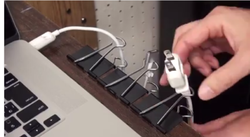 SMS VP John Hoeschele SMS VP John Hoeschele As new generations enter the marketing profession -- and as the tools and technologies available to incoming and current professionals evolve and improve -- it is nevertheless useful to revisit some of the basic tenants of our discipline which, new bells and whistles aside, may not have changed all that much at their foundation. In my estimation, one such category is participation in trade shows. As such, I thought I'd recap some of the ways to ensure a strong performance and measurable results at your next such event. At SMS, we divide the trade show planning process into three distinct and more easily managed stages. Let's take a look at each one. BEFORE THE SHOW:
DURING THE SHOW:
AFTER THE SHOW:
Got a trade show, or two, or a dozen coming up? Dividing them into these three, bite-sized chunks will help you ensure success. And, as ever, give us a call if you'd like to discuss the possibilities or could use some help. (We genuinely love this stuff!) -- John H.
1 Comment
A student from Cazenovia College that I recently had the privilege to mentor during his senior year is now out in the world of work. Wisely staying in touch with me, as doubtless the college's career center advised him to do (this is a smart and driven kid), he wrote me recently looking for any insights I might have as he enters his second job (this time at a legit and 'hot' NYC ad agency). I thought it might warrant a more public distribution in case it proves useful to other incoming communications/advertising professionals. With that context, I'll pick up my email's introductory salutations and comments left off...
...in any case, [John Doe], the only advice I’d be audacious enough to offer:
Thanks for listening, John Hoeschele / VP  Annie Kluger, Intern Annie Kluger, Intern The lifestyle of a college student is unique: During these four years we spend all our time surrounded by people our own age; students do not usually make much money while in school (but we do have some!); and the social and financial situations of college students make us a hard audience to appeal to as a brand, but if you do reach and connect with us, we’ll likely appreciate you for years to come. Going into my last year of college, here are the insights I can offer to marketers on the most effective ways a brand can market to students. Offer Deals and Discounts On Monday nights, one of the pizzerias in my college town serves slices and beers for only one dollar. Despite there being a dozen or so other places to eat in town, students will wait in a crowded line if it means they spend little money. Since our financial expenses are more than our incomes as students, we are always in search of the best deals and prices. Buy “Social” Most of my peers have had some form of social media accounts since middle school. Opening our phone screens to scroll through our social media feeds while walking to class is now just second nature. As a result, our attention is already on our social media so it is a smart place to get a paid advertisement noticed by students. Get “Social” In addition to placing advertisements on social media, it is also beneficial for a brand to have social media accounts to interact with customers. When social media first began it was a way to connect with friends and see what they were doing. Now my Instagram feed is a combination of posts from both my friends and my favorite brands. Social media is no longer just a way to socialize but also a way to market. If a brand has its own media accounts, it is keeping up with the trends and college students will see it as hip. Since we are so familiar with connecting through these outlets we are more likely to relate to brands that are also using them. Hire Some Brand Ambassadors Youth-savvy companies often hire students to be ambassadors for their brands. These students will set up tables on campus to offer information on a product to other students. This is a convenient and easy way for students to land a job without having to travel far. It is an equally a great opportunity for brands to share their names and brand messages to college students with the use of familiar faces. Visit Campuses College campuses host informational events for students throughout the school year. If your brand can set up a table at an event, it is a great way to expose your name and present information directly to students. Visits to schools also give representatives from brands a chance to gain feedback from students and create more personalized relations with them. Deliver Great Customer Service and Product Quality in the First Place Life on a college campus means constant contact with other students. The reputation of a brand will spread quickly from student to student, making “word of mouth” an especially important and powerful concept on college campuses. It is important for a brand to have positive interactions with customers for positives messages to be shared. Make Your Product Easy-to-Access As a freshman in college, I did not have a car on campus which made it hard to get what I needed. Whenever I needed something I had to figure out how I could get it to my dorm room in the quickest and cheapest way. The easier a product is to access, the more likely it is to be snapped up by students. Offer Giveaways Giveaways are a good way to encourage students to engage with and test a brand. Often brands will ask for participants in giveaway offers or contests to post to their own social media pages with a specific hashtag to enter a contest. This means customers will use their own social media pages for the promotion of a brand, which adds consumer credibility and is yet another form of the “word of mouth” marketing I mentioned earlier. Promote Your Product/Service in a Publication Targeting the College-aged Demographic My first year of college, I wrote for an online publication with content specifically directed towards women in college. The smartest brands routinely sent products to the student editors of the publication, encouraging the editorial staff of students to do written reviews of the products supplied. Not surprisingly, readers liked to see reviews that came from other students because those assessments tended to be honest and addressed real concerns students had. Acknowledge the Stand-out Moments College graduations, spring breaks, and final exam weeks are all unique events specific to being a student in college. These events provide opportunities for marketers to promote products relevant to these times in our lives. In other words, connect with us at these pivotal times, and there’s a good chance will prefer your brand during ordinary times too!  John Hoeschele, Creative Director John Hoeschele, Creative Director You've doubtless heard, and by now, begun to appreciate that video is increasingly the way both B2C and B2B 'consumers' prefer to receive their content. Without getting too deep into why that is the case -- chief among the reasons is how strapped for time we've all become, followed closely and not coincidentally by the Internet's much-improved methods and speeds for delivering video content -- we thought we'd quickly rattle off ways that videos can and should be distributed and even 're-purposed' to help you squeeze every last drop of ROI out of them. Recognizing you're short on time, yourself -- we'll start by directing you to a 1-page flyer you can download on the subject. While not 100% comprehensive, it can serve as a sort of checklist you can use in your company whenever a video asset becomes available. You can access/print/download it here. For folks with time enough to hang with me for a couple more paragraphs, here are some real-world examples of what I'm talking about:
 John Hoeschele, Creative Director John Hoeschele, Creative Director One thing that's intrigued me over nearly 30 years in the marcom business is the commonality of marketing retail products vs. technology products vs. industrial products. Clients, of course, believe their industries are 'totally unique' -- which is true to a certain extent. But one of the advantages of being an objective outsider/consultant is that we can sometimes see patterns and parallels you may not see when you're in among the trees. As one for instance, consider how the leverage point for marketing products can shift, if circumstances are right, from the manufacturers of said products to their distribution or 'channel' partners... Typically this happens when it dawns on the channel that it has the more enviable position of being closer to the end-customer. Some examples:
Why should such parallels matter to you as a marketer? Most importantly, setting your sights on trends, technologies, and behaviors in adjacent or even distant industries can yield insights or ideas that might be applied in your own, in turn yielding competitive advantages. A few years back, I was fortunate enough to be a sub-contracted copywriter on a project for the razor giant Gillette: The project in question entailed turning an old razor blade factory in Boston into a very slick Retail Innovation Center, where the company would develop, test, and spotlight its latest retail marketing concepts (e.g. packaging, displays, promotions) for increasingly the tough-to-please retailers mentioned above. Even though the category here was decidedly consumer -- wouldn't Gillette's approach be of interest to any industrial or tech OEM faced with increasing mindshare at their own, increasingly tough-to-please channel partners? Point is, looking past your particular forest can really get your noodle going. And that's when you're most likely to generate business-building ideas and, yes, maybe even a genuine breakthrough or two. Cheers! -- JH  John Hoeschele, Creative Director John Hoeschele, Creative Director I can't tell you how many people start a dialogue with me about marketing with "I need a brochure." Far from the glee you'd expect of me to feel on these occasions, I'm usually fearful that my colleague has come to the answer before he or she has even asked the right question. Like "Is a brochure really the best way to sell to or connect with my audience?" Or "Who is really the decision maker we're trying to reach?" Or, even before either of these, "Why us vs the bazillions of other competitors out there who are ready, willing, and able to munch our lunch?" To add even more misfortune to this scenario, rare is the printer or one-person graphic design shop who'll raise these more fundamental questions rather than chalk up an easy brochure job, a la: "Whoa Bob... Sounds to me like your brochure budget is better spent on enhancing your call center or doing some market research!" Look, with or without an outside strategist like SMS, you owe it to yourself to take aim before you pull the trigger. Because the awful truth is maybe you don't need a new brochure, or a new logo, or a new website. Case in point: A few years back, I headed up a creative department assigned to the Scientific-Atlanta account. (At that time, SA was a $1.8 billion manufacturer of technology for the cable-TV market; today, they are embedded in Cisco). Our client-side contact at the time needed to launch a new type of rack-mounted transceiver to cable system operators (MSOs) around the U.S. (Without getting into too much detail here, this product offered a more modular way to handle/juggle multiple data streams of then-popular shows like The Sopranos and Pimp My Ride.) The client assumed a double-truck ad in the major cable-industry trade rags was pretty much a given. We replied: "But why? Your target audience is literally comprised of 50 or so chief technical officers at these cable systems -- so while you'd certainly hit some of them, you'd be wasting a ton of money on the many other largely disinterested eyeballs who subscribed to these pubs." Research further indicated that face-to-face contact was critical to opening up any sort of serious dialogue with the audience on this sort of product. So, instead of an ad, we recommended purchasing 50 disposable voice recorders... Having SA's VP of biz dev read a scripted but also customized message to each recipient on the list, including a request for an interview at the upcoming industry-favorite trade-show... And then mailed the recorders in a cool box to the target list. Far from the 2-4% response considered strong by the standards of those days, we secured 22 appointments -- all of them with heavy hitters and most of them abuzz with how cool the invitation was. So, before you leap, are you SURE you need a BROCHURE? Cheers! -- JH  John Hoeschele, Creative Director John Hoeschele, Creative Director If you're like most professionals, you've had occasion to listen to (maybe endure?!) a dozen or more 'talks' in your career. Also like most folks, chances are you've also asked yourself: "I wonder if I could and should do a talk like this on what I know?" Well, I'm here to tell you that you not only can -- but you probably should -- make the effort of doing some talks (aka: lectures, speaking engagements, speech, presentations, etc.) in your work life. Bonus: Even if public speaking does rank 13th among human fears ("glossophopia"), it's way easier than you might think to tee this ball up and give it a whack. The 'why' of it is threefold. First and foremost for the marketing-minded, public speaking is good exposure for your company. (This assumes, of course, that your subject matter will relate to what you actually do for a living and that your audience is a match for your topic, too: Meaning, it's probably not a nifty idea for a patent attorney to speak about bathroom tiling techniques at a circus-clown convention.) By exposure I mean credibility, brand awareness, word of mouth, and possibly even lead generation. Second, being able to state and substantiate that you're a public speaker and subject matter expert is broadly good for your professional reputation and specifically good fodder for your resume and LinkedIn profile. (That's not to say you should list every gig on your resume; rather, just list public speaking as a skill and -- yeah -- keep a separate log of your talk topics and venues, for your or your employer's future reference.) And, finally, it's just good practice for those common occasions when you may be asked to rise-and-shine verbally, be it business contexts like company meeting, sales presentations, department meetings, or company open houses -- or extra-curricular talks occasioned by volunteer activities, schooling, weddings, or (sadly) funerals. As for the 'how?' I'll list the basics here and keep them super simple: 1) Set your goals. Are you presenting to establish corporate credentials in a new product or service sphere? Generating and cultivating prospects? Increasing your own public speaking skills? (Nothing wrong with that!) Write down any and every objective you have, and be sure to revisit them throughout planning and authoring process to make sure you're not wandering into the weeds. 2) Pinpoint your topics. First, what process, product, problem, or subject do you know well enough to chat about comfortably and at length, including fielding questions that may arise from the audience? Next, narrow it down to something digestible, compelling, and (ideally) original, since presenting on a topic that's too broad or cliche is a one-way ticket to Yawnsville. (A handy idiom to keep in mind: Leave a message, not a mess!) And, finally, continuously revisit the goals you set at the onset. Here are a couple examples of super-narrow-topic talks, that help make the point:
3) Identify & solicit suitable audiences. At a topmost level, this means revisiting who your company's regular 'targets' are -- and then researching and reaching out to audiences comprised of said targets, such as trade associations or interest groups. Also note that I used the plural form of "audience": That's because there's a distinct possibility you can re-present your material to multiple, similar groups. For instance, if you're a wealth management expert presenting to one Rotary Club, why not make the same presentation to the one in the next zip code? 4) Write your presentation(s). Keep in mind these rules of thumb:
5) Prepare, prepare, prepare! Both by writing your notes/script (SMS can help with that, btw!) and doing dry runs with willing test audiences. 6) Lock down logistics. Who is providing the screen, the laptop, and the projector? Will there be IT or AV support on hand? Should you send your slide-set ahead of time for pre-loading or are you expected to bring it with you on a memory stick? What's your plan B if the power goes out or there's some other insurmountable technical glitch (aka: at least bring one print out for yourself, if not handouts for all)? 7) Help your host organization promote your talk before and afterwards. And, for goodness sake, make sure someone takes a pic or records your presentation for immediate (meaning social media) or future use. Otherwise your effort is literally here today, gone tomorrow. 8) Show up early, make sure you're cued up, feel free graciously skip the meal if it helps you stay focused, take a deep breath, and rock it! Some final quick tips:
That's all there is to it. Now get out there, clear your throat, and talk the talk! -- JH  Doug Smith, President Doug Smith, President Times were, the folks developing new products for your company had months, even years to ‘build’ whatever was in the pipeline. And you, as the marketing or marketing communications manager assigned to the project, had more or less the same amount of time to develop a suitably well-targeted, hard-hitting, and on-message marcom campaign to introduce said new products to the universe. Flash forward to today, and -- whether the new product or service in question is entirely novel to your company or a next-gen version of an earlier offering – there can be no doubt the concept-to-realization timeline is far more compressed. Credit for this new reality is shared by what one might call fundamental causes and enabling capabilities, a very few of which I’ve listed below: Some causes of today’s compressed product development cycles
Some of the enabling capabilities that contribute to today’s compressed product development cycles
But whatever the cause or the enabler, it is clear that development of marketing programs must keep pace with, support, and (ideally) even identify and glean value from today’s accelerated product development and introduction regimens. One way is to accomplish this is to have your marcom program mirror and participate in your product development team’s ‘agile’ process. Step one? Understand the hallmarks of the agile process, which include:
Not only will you be joining your agile team, your marketing program is likely to be better supported internally, better informed by customer input, and more resonant as a result. (FOR MORE WAYS TO ENSURE A SPEEDY MARCOM PROGRAM, READY OUR WHITE PAPER.) Thanks for listening. DCS Tell us what you think of this blog or write me to receive future installments here.  John Hoeschele, Creative Director John Hoeschele, Creative Director With the arrival of spring -- and the fly-fishing season -- I recently went to my local Walmart to secure my 2016 fishing license. After a few minutes standing at the sports supplies counter, an employee informed me the 'system was down' -- which I took to mean a faulty connection to the NYS Department of Conservation, which issues such licenses through participating retailers. The Walmart staffer suggested I go down the road a few blocks to Kmart. A little frustrated, but at least pleased to have received a suggestion for an alternative source, I headed for Kmart where walked up to the counter in the sports department with the selfsame objective... After grabbing a bottle of dish detergent I noticed on the way through the store, since it reminded me we needed some at home at that moment. "Do you have fishing licenses here?" I asked optimistically. The person behind the counter, who I soon discovered to be the department manager, looked at me suspiciously. "Mind if I ask if you came here first?" "Well, no, since you ask. I went to Walmart first and their system was down." "Hmmph..." he answered, with obvious disgust. "That always happens. And when it does, they send people here." A little taken aback by his frankness, and annoyance, I asked "Well, you do still make some money on selling licenses, right?" "Barely," he quipped. "At least YOU'RE buying something else. Most people just walk in, get the license, and walk out again without buying anything." Overriding the impulse to do my best, Steve Martin-esque "Well excuuuuuussssseeee ME!" -- and swallowing my disbelief at how utterly inappropriate it was for a retail employee (let alone the danged department manager) to be overtly miffed at me for being so self-serving as to shop his Kmart for something the Walmart down the road didn't have -- the marketing side of my brain was nevertheless officially blown. Not just because the manager was rude, but because so many marketing opportunities weren't being realized. A savvy marketer would not only have NOT whined at me about the situation, he would have:
In other words, consider me one more fish that got away. JH Tell us what you think of this blog or write me to receive future installments here. ; ) 
Before my 19 year old daughter headed for semester of college abroad, we headed to the local mall to shop for clothes that ensured she was suitably fashionable. (Me? I would have just thrown my most comfortable jeans, tees, and sneakers in a backpack and headed for the airport. But teenage girls? Well, you know.) So there we were milling around in Urban Outfitters, in what is probably a common (if slightly pathetic?) twosome: A father, trying to find a quiet corner or pillar to lean against until he is called upon for his credit card -- and his daughter, methodically moving from rack to rack, rapidly ruling items "in" or "out" based on some highly specific, but impossible-to-articulate criteria.
As I sat dad-like, on an out-of-the way platform near the front window, my eyes wandered and, per usual, began to focus on the minute details that make up an environment. What is it that makes an Urban Outfitters store feel like an Urban Outfitters? (Spoiler alert: A deep dive into the intricacies of retail space design is not where I'm heading with this particular post.) The pre-worn and pre-torn jeans, frilly tops, and crafted accessories are critical to the picture, to be sure. Then, there's enormously current alternative music, which -- though, piped throughout the store -- somehow appears to be provide the sensation of individual soundtracks for each teen's and 20-something's shopping experience. My daughter included. Next, you have to credit the invariably attractive, inked and/or pierced, and seemingly gender-fluid sales associates bustling about, tidying up the inventory, and facilitating checkouts. And, finally, there are the hardwood floors, exposed pipes and air-ducts in the ceiling, and the steam-punk inspired clothing racks themselves...all of these accents of environmental design meticulously chosen to foment the feeling you have discovered a genuine stash of edgy fashions in the basement of some, industrial-era Manhattan basement instead of a recently sheet-rocked stall of decidedly sub-urban shopping mall. Putting aside the cynicism of that last observation (as a father, it is true, I sometimes despair!) -- let's focus instead, as I did that day, on those industrial-looking racks (aka: 'retail fixtures') for a moment. And ask this question: Who supplies the thousands of linear feet of iron piping, cases of castor wheels, and faux, Edison-era lighting fixtures to this and other Urban Outfitters across the U.S. (not to mention the hundreds of similarly vibe'd competitive chains like American Eagle, Aeropostale, Old Navy, et al)? Allowing for variations of the multi-tier supply chain involved in this sort of thing -- doubtless, corporate buyers, retail store designers, and retail fixture distributors all play a role -- somewhere at the back of the line the are actual foundries, metal-working shops, and other assorted manufacturers of the pipe, fittings, wheels, woodblock, and fixtures we as consumers have come to expect in today's hipster retail environments. Companies... > who used to produce their wares exclusively for construction applications; > who used to sell exclusively to industrial customers; > who used to sell only through industrial distributors; ...and all of whom, at some point, had nary a thought of selling their grimy, gritty, and above all functional industrial goods into retail settings simply because they look cool. Now, I have a suspicion that the fashion industry (or fixture designers and makers) approached the industrial folks on this one, rather than the inverse. Nevertheless, a new market for existing materials resulted from the exercise of looking at an age-old product through new lenses. For another dramatic example of this sort of stand-on-your-head, new-market-for-existing-products thinking -- check out this life-hacker video that whips through a handful of alternative ways to use an ordinary binder clip in an office environment. Sure, some of these are silly or impractical, but some of might yield legitimate, new revenue streams if the ideas were re-packaged and marketed the right way. (If I were a clip or other commodity office products manufacturer, I'd consider charging someone on staff with replicating the process captured in this video. Marching order: "What other ways can one use our product... 1, 2, 3: Go!" So, if you've got product at the mature phase of its life cycle, before writing it off, so to speak, you may want to consciously consider it from a new vantage point: There might be new life, and new sales, awaiting you in an entirely new market. Tell us what you think of this blog or sign up to receive future installments here. ; ) |
About MarketingMinds
Welcome to the official blog of Ithaca, NY-based Smith Marketing Services. Authored by members of the SMS team (we take turns or just chime in when inspiration strikes), MarketingMinds offers up Archives
March 2018
Categories |



 RSS Feed
RSS Feed